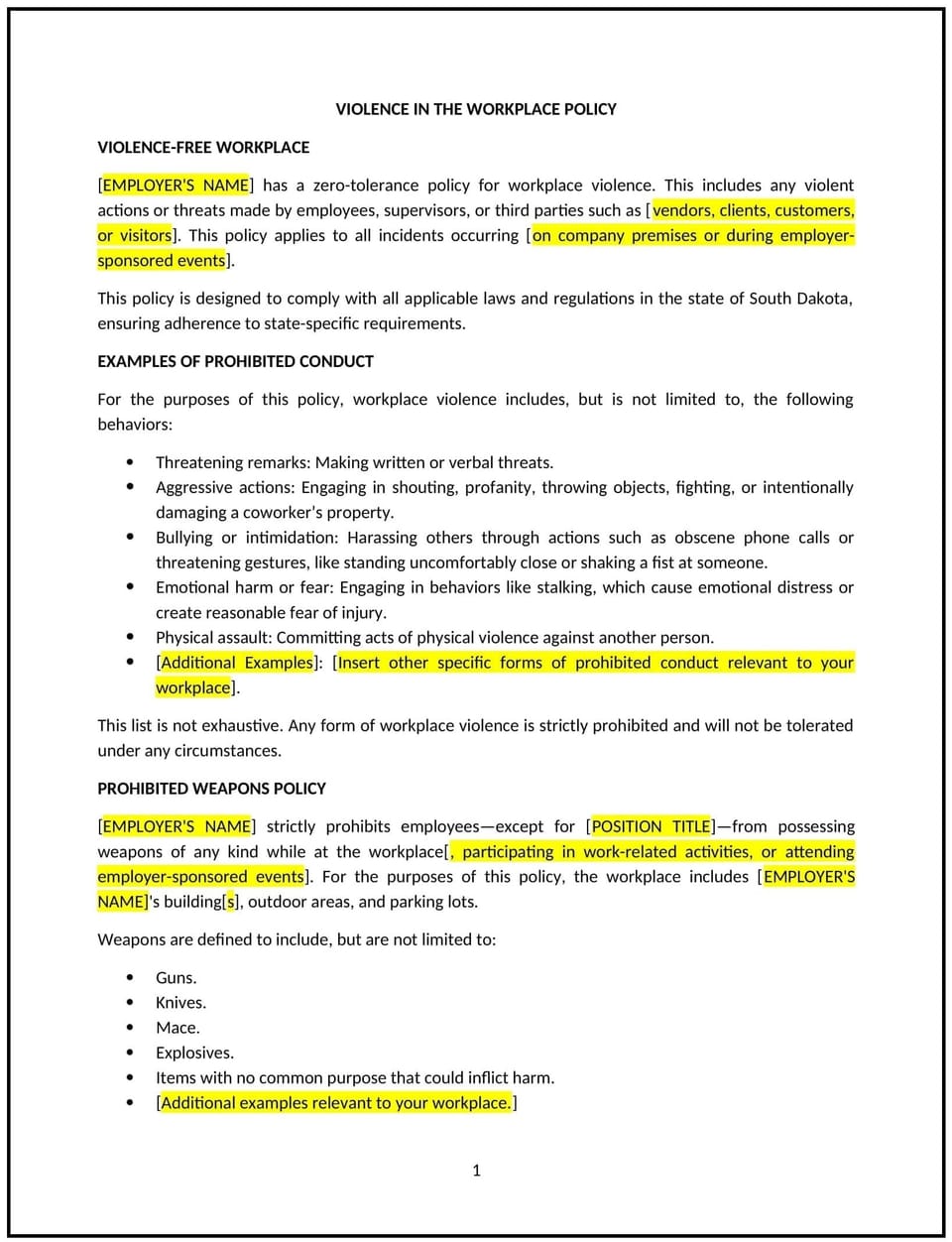Violence in the workplace policy (South Dakota): Free template

Violence in the workplace policy (South Dakota)
This violence in the workplace policy is designed to help South Dakota businesses establish guidelines for preventing and addressing violent behavior in the workplace. It outlines procedures for reporting incidents, ensuring employee safety, and maintaining a respectful work environment.
By adopting this policy, businesses can promote a safe workplace, reduce risks, and align with general best practices for workplace safety.
How to use this violence in the workplace policy (South Dakota)
- Define workplace violence: Specify what constitutes violent behavior, such as physical assault, threats, or harassment.
- Establish reporting procedures: Provide steps for employees to report incidents of violence, including anonymous reporting options.
- Address safety measures: Outline actions to protect employees, such as emergency response plans or security measures.
- Set consequences: Explain the disciplinary actions for engaging in violent behavior, such as warnings, suspension, or termination.
- Train employees: Educate employees on recognizing and reporting violent behavior, as well as de-escalation techniques.
- Provide support: Include resources for employees affected by workplace violence, such as counseling or employee assistance programs (EAPs).
- Review and update: Assess the policy annually to ensure it aligns with evolving workplace needs and legal standards.
Benefits of using this violence in the workplace policy (South Dakota)
This policy offers several advantages for South Dakota businesses:
- Promotes a safe workplace: Establishes clear guidelines for preventing and addressing violent behavior.
- Reduces risks: Helps mitigate the likelihood of workplace incidents and associated legal or financial liabilities.
- Aligns with best practices: Demonstrates a commitment to maintaining a safe and respectful work environment.
- Enhances employee confidence: Shows employees that the business prioritizes their safety and well-being.
- Supports compliance: Helps businesses align with workplace safety regulations and standards.
Tips for using this violence in the workplace policy (South Dakota)
- Communicate the policy: Share the policy with employees and include it in the employee handbook.
- Provide training: Educate employees and managers on recognizing, reporting, and preventing workplace violence.
- Monitor compliance: Regularly review incident reports to ensure adherence to the policy.
- Address issues promptly: Take immediate action to investigate and resolve reports of violent behavior.
- Update regularly: Review the policy annually to ensure it remains relevant and effective.
Q: How does this policy benefit businesses?
A: It promotes a safe workplace, reduces risks, and aligns with best practices for preventing workplace violence.
Q: What constitutes workplace violence?
A: Workplace violence includes physical assault, threats, harassment, or any behavior that creates a hostile or unsafe environment.
Q: How should employees report incidents of violence?
A: Employees should follow the outlined reporting procedures, which may include notifying a supervisor, HR, or using an anonymous reporting system.
Q: What support is available for employees affected by workplace violence?
A: Businesses can provide resources such as counseling, employee assistance programs (EAPs), or referrals to external support services.
Q: How often should businesses review this policy?
A: Businesses should review the policy annually or as needed to ensure it aligns with evolving workplace needs and legal standards.
This article contains general legal information and does not contain legal advice. Cobrief is not a law firm or a substitute for an attorney or law firm. The law is complex and changes often. For legal advice, please ask a lawyer.


